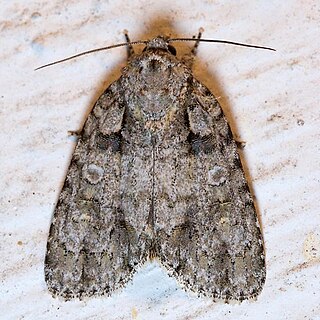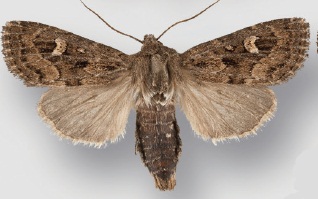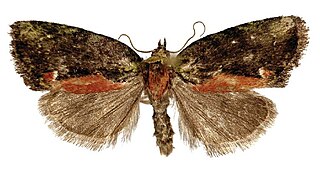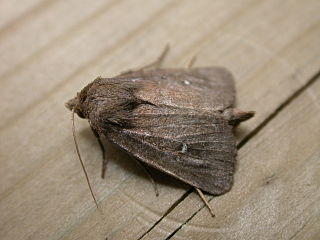
Xestia is a genus of noctuid moths. They are the type genus of the tribe Xestiini in subfamily Noctuinae, though some authors merge this tribe with the Noctuini. Species in this genus are commonly known as "clays", "darts" or "rustics", but such names are commonplace among Noctuidae. Xestia moths have a wide distribution, though they most prominently occur in the Holarctic.

Apamea is a genus of moths in the family Noctuidae first described by Ferdinand Ochsenheimer in 1816.

Amphipyra is a genus of moths in the family Noctuidae, the only genus in the tribe Amphipyrini.

The Thyatirinae, or false owlet moths, are a subfamily of the moth family Drepanidae with about 200 species described. Until recently, most classifications treated this group as a separate family called Thyatiridae.

Acronicta increta, the raspberry bud dagger moth, raspberry bud moth or peach sword stripe night moth, is a moth of the family Noctuidae. The species was first described by Herbert Knowles Morrison in 1875. It is distributed throughout the south of Canada and the United States down to Florida and Texas.

Archanara is a genus of moths of the family Noctuidae.

Drasteria is a genus of moths in the family Erebidae.

Lithophane is a genus of moths of the family Noctuidae. They spend the winter as adults.

Psaphida is a genus of moths of the family Noctuidae. The genus was erected by Francis Walker in 1865.

Resapamea is a genus of moths of the family Noctuidae.

Stenoloba is an East Asian genus of moths of the family Noctuidae. The genus was described by Staudinger in 1892.

Globia is a genus of moths called "arches", in the family Noctuidae. There are about seven described species in Globia. They are found in the holarctic.

Globia oblonga, the oblong sedge borer, is a moth of the family Noctuidae. The species was first described by Augustus Radcliffe Grote in 1882. It is found across southern Canada from the Maritimes to British Columbia, south to the Gulf of Mexico and southern California.

Globia subflava, the subflava sedge borer or yellow sedge borer, is a moth of the family Noctuidae. The species was first described by Augustus Radcliffe Grote in 1882. It is found in North America from Nova Scotia west to British Columbia, south to New Jersey in the east and Utah and California in the west.

Globia algae, the rush wainscot, is a moth of the family Noctuidae. The species was first described by Eugenius Johann Christoph Esper in 1789. It is found in central and southern Europe, Turkey, Armenia, northern Caucasus, south-west Siberia.

Lenisa is a monotypic moth genus of the family Noctuidae erected by Michael Fibiger, Alberto Zilli and László Aladár Ronkay in 2005. Its only species, Lenisa geminipuncta, was first described by Adrian Hardy Haworth in 1809. It is found in southern and central Europe, Lebanon, Israel, Turkey, Iraq and in the Caucasus. Some authors place this genus name as a synonym Archanara, and the species as Archanara geminipuncta.

Schinia lucens, the leadplant flower moth or false indigo flower moth, is a moth of the family Noctuidae. The species was first described by Herbert Knowles Morrison in 1875. It is found in the central and western United States.

Xestia dilucida, the dull reddish dart or reddish heath dart, is a moth of the family Noctuidae. The species was first described by Herbert Knowles Morrison in 1875. It is found in the United States from southern Maine to northern Florida, west to central Ohio and eastern Texas.

Eutricopis nexilis, the white-spotted midget, is a moth of the family Noctuidae. The species was first described by Herbert Knowles Morrison in 1875. It is found in North America from Nova Scotia and New England west across southern Canada to southern Vancouver Island, north to Yukon and south in the mountains to California and Colorado.
Periploca laeta is a moth in the family Cosmopterigidae. It was described by Ronald W. Hodges in 1962. It is found in North America, where it has been recorded from Florida, Arizona, Illinois, Ohio, Quebec and West Virginia.

















